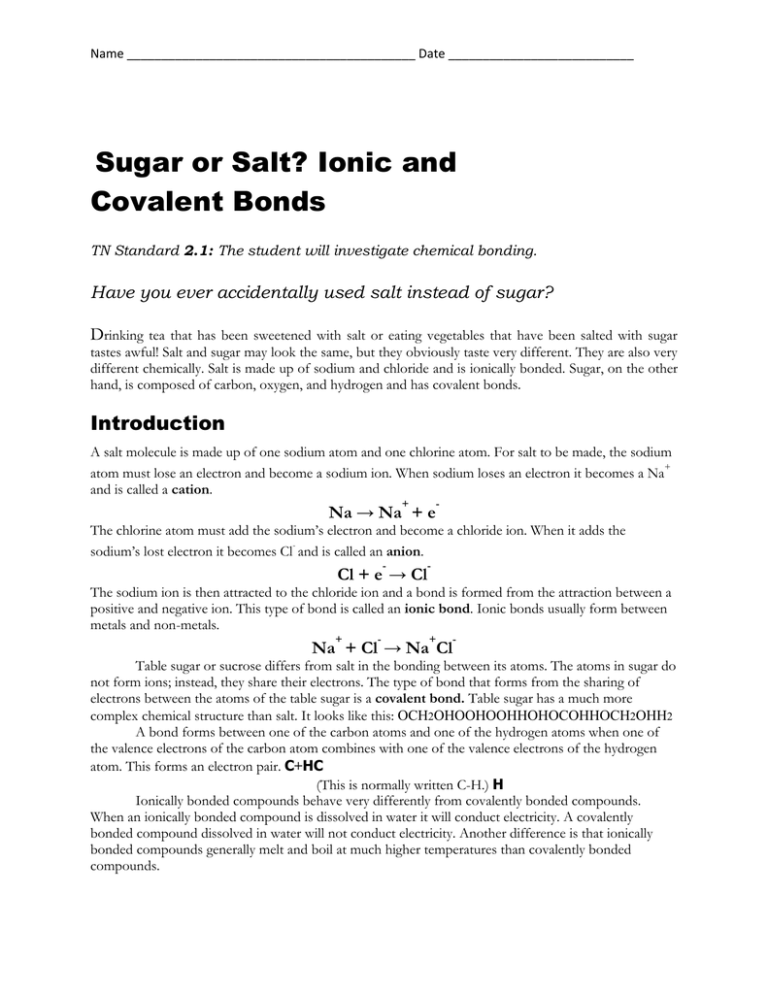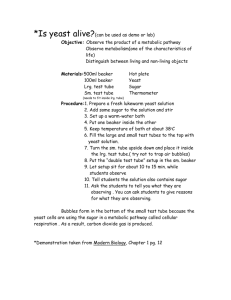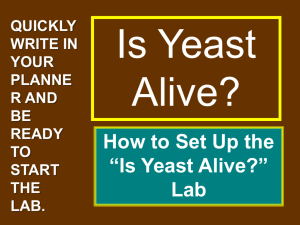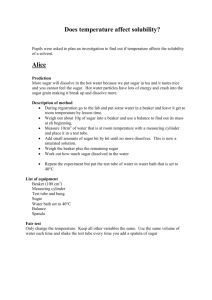Sugar or Salt? Ionic and Covalent Bonds
advertisement

Name __________________________________________ Date ___________________________ Sugar or Salt? Ionic and Covalent Bonds TN Standard 2.1: The student will investigate chemical bonding. Have you ever accidentally used salt instead of sugar? Drinking tea that has been sweetened with salt or eating vegetables that have been salted with sugar tastes awful! Salt and sugar may look the same, but they obviously taste very different. They are also very different chemically. Salt is made up of sodium and chloride and is ionically bonded. Sugar, on the other hand, is composed of carbon, oxygen, and hydrogen and has covalent bonds. Introduction A salt molecule is made up of one sodium atom and one chlorine atom. For salt to be made, the sodium + atom must lose an electron and become a sodium ion. When sodium loses an electron it becomes a Na and is called a cation. + - Na → Na + e The chlorine atom must add the sodium’s electron and become a chloride ion. When it adds the sodium’s lost electron it becomes Cl and is called an anion. - - Cl + e → Cl The sodium ion is then attracted to the chloride ion and a bond is formed from the attraction between a positive and negative ion. This type of bond is called an ionic bond. Ionic bonds usually form between metals and non-metals. + - + - Na + Cl → Na Cl Table sugar or sucrose differs from salt in the bonding between its atoms. The atoms in sugar do not form ions; instead, they share their electrons. The type of bond that forms from the sharing of electrons between the atoms of the table sugar is a covalent bond. Table sugar has a much more complex chemical structure than salt. It looks like this: OCH2OHOOHOOHHOHOCOHHOCH2OHH2 A bond forms between one of the carbon atoms and one of the hydrogen atoms when one of the valence electrons of the carbon atom combines with one of the valence electrons of the hydrogen atom. This forms an electron pair. C+HC (This is normally written C-H.) H Ionically bonded compounds behave very differently from covalently bonded compounds. When an ionically bonded compound is dissolved in water it will conduct electricity. A covalently bonded compound dissolved in water will not conduct electricity. Another difference is that ionically bonded compounds generally melt and boil at much higher temperatures than covalently bonded compounds. Name __________________________________________ Date ___________________________ In the first part of this lab you will investigate how ionically bonded and covalently bonded substances behave differently in their conduction of electricity. You will do this by using a simple anodizing apparatus. A stainless steel screw and an iron nail will be used for the electrodes. In an anodizing apparatus, the water must contain enough ions to conduct electricity. Then the water will react to form hydrogen and oxygen gases. 2H2O → 2H2 + O2 Since the stainless steel screw is not very reactive, bubbles can be seen coming off of it. The iron nail will react with the oxygen to form iron oxide which is commonly called rust. This can be seen on the nail after the reaction proceeds for several minutes. In the second part of this lab you will explore the differences in melting points between ionically bonded and covalently bonded compounds. You will do this by placing a small amount of sugar in one small test tube and heating it at different heights over a Bunsen burner. You will then repeat this procedure using salt instead of sugar. Objectives • To understand the difference between ionic and covalent bonding. • To link ionic and covalent bonding with their physical properties. Pre-lab Questions 1. What is an ionic bond? ______________________________________________________________ ____________________________________________________________ 2. What is a covalent bond? ______________________________________________________________ ____________________________________________________________ 3. Do you think sugar or salt will melt at a higher temperature? Explain your answer. ______________________________________________________________ ______________________________________________________________ ____________________________________________________________ Name __________________________________________ Date ___________________________ Procedure Part 1. Nail Test for Ionic Bonding MATERIALS NEEDED 1. Rinse a clean 150 mL beaker several times with deionized water to prevent contamination from ions that may be on the beaker. Fill the beaker about ¾ full with deionized water. 2 packets of sugar 2 packets of salt 9-volt battery 2 rubber bands Deionized water 1 Iron nail 2 Wire leads with alligator clips on each end 1 Stainless steel screw 150 mL beaker Stirring rod 2 small test tubes Spatula Test tube holder Striker Bunsen burner Sharpie marker Ruler 2. Pour a packet of sugar (~3 g) into the 150 mL beaker. Stir the solution with a clean stirring rod until the sugar is dissolved and the solution is well mixed. 3. Stretch two rubber bands around the 150 mL beaker. Be careful not to spill any of the solution. The rubber bands should loop from the top to the bottom of the beaker. Position the 2 rubber bands next to each other (Figure 1). HINT: Do not position the bands around the circumference of the beaker. 4. Attach the alligator clip on one end of a wire lead to just underneath the flat head of an iron nail. Place the iron nail between the 2 rubber bands on one side of the 150 mL beaker. The end of the nail should be in the solution while the head with clip is resting on the rubber bands. 5. Attach the alligator clip on one end of another wire lead to just below the head of the stainless steel screw. Place the screw between the 2 rubber bands on the opposite side of the 150 mL beaker. Make sure the end of the screw is in the solution and the head with the clip is resting on the rubber bands. 6. Connect the alligator clip on the other end of the wire lead that is attached to the nail to the (+) terminal of a 9-volt battery. CAUTION: Be careful when using energy sources such as batteries around water. Name __________________________________________ Date ___________________________ 7. Connect the alligator clip on the other end of the wire lead that is attached to the screw to the (-) terminal of a 9-volt battery. CAUTION: Be careful when using energy such as batteries around water. 8. Allow the apparatus to stand for two minutes and make observations. Record your observations in Part 1 of the data section. 9. Thoroughly clean the glassware, nail and screw with deionized water. 10. Repeat the procedure using a packet of salt (~0.65 g) instead of the sugar. Part 2. Melting points 1. Place a spatula tip full of sugar into a small test tube. The sugar should just coat the bottom of the test tube. CAUTION: Be sure the test tube does not have any small cracks or chips in it. 2. Light a Bunsen burner and adjust the flame to where it is approximately 2 -3 inches tall and has a blue inner cone. CAUTION: Long hair should be tied up and loose clothing restrained when around an open flame to prevent fire and burns. Be sure you are wearing your safety goggles. 3. Place the test tube containing the sugar in a test tube holder. Hold the test tube at a slight angle approximately 4 inches above the top of the burner. Continue to hold the test tube in the flame until the sugar just begins to melt. If it does not melt after ~15 seconds, go on to step 4. If it has melted, go to step 6. HINT: If you keep the sugar in the flame until it turns dark brown or black, you will not be able to clean the test tube. 4. If the sugar did not melt in step 3, lower the test tube until the bottom of the test tube is touching the top of the flame. Hold it there until the sugar just begins to melt or for ~15 seconds. 5. If the sugar still does not melt, lower the test tube until the bottom of the test tube is located at the top of the inner blue cone of the flame. This is the hottest part of the flame. Hold it there until the sugar just begins to melt or for ~15 seconds. 6. Allow the test tube to cool to room temperature before touching it. CAUTION: The test tube will be very hot and can burn your skin if touched before it cools. Hint: After the test tube has cooled for a few seconds, place it in a beaker or wire test tube rack to finish cooling and continue with the procedure. 7. Record your observations in the data section. 8. Repeat the procedure using salt instead of the sugar. 9. Turn off the Bunsen burner. Make sure the test tubes have cooled to room temperature before touching them. CAUTION: The test tube will be very hot and can burn your skin if touched before it cools. 10. Record your observations in the data section. 11. Clean-up: The sugar and salt solutions can be poured down the drain. Rinse the beaker, screw, nail, and stirring rod several times with deionized water. Clean the test tubes with water first and then rinse them with deionized water. They may need to soak for a few minutes in hot water in order to remove the melted substances. Name __________________________________________ Date ___________________________ Data • Observations for the sugar solution: • Observations for the salt solution: • Observations for the melting of sugar: • Observations for the melting of salt: Post Lab Questions (These should be typed and attached to your lab report) 1. Why is deionized water instead of tap water used in Part 1? ______________________________________________________________ ______________________________________________________________ ____________________________________________________________ 2. In Part 1, why did you not observe a stream of bubbles coming off of the stainless steel screw with the sugar solution? ______________________________________________________________ ______________________________________________________________ ____________________________________________________________ 3. Why do you think you may see a few bubbles forming in Part 1 with the sugar solution? ______________________________________________________________ ______________________________________________________________ ____________________________________________________________ 4. In Part 1, why did you observe a stream of bubbles coming off of the stainless steel screw and rust forming on the nail with the salt solution? ______________________________________________________________ ______________________________________________________________ ____________________________________________________________ 5. In Part 2, which of the substances had the lower melting point? Was this what you expected? Explain your answer. ___________________________________________________________________________ ___________________________________________________________________________ Name __________________________________________ Date ___________________________


